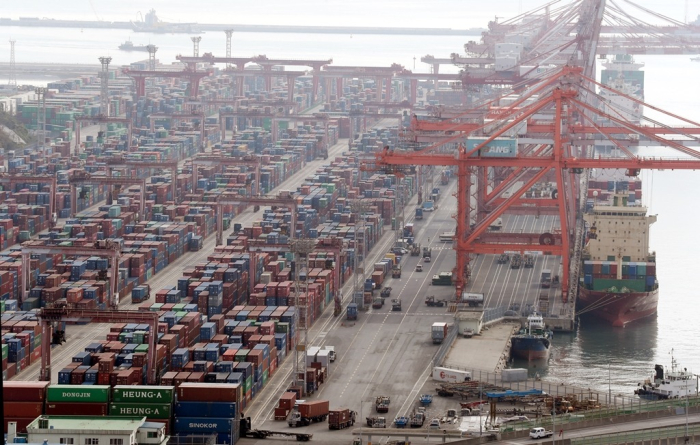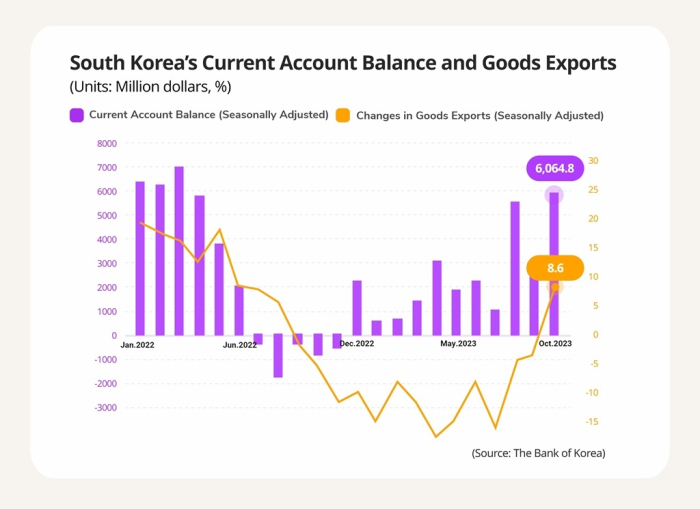Economy
Korean current account surplus at 19-month high on exports recovery
Goods account surplus hits two-month high in October on slower decline in chip exports; services account deficit nearly halves
By Dec 08, 2023 (Gmt+09:00)
2
Min read
Most Read
LG Chem to sell water filter business to Glenwood PE for $692 million


Kyobo Life poised to buy Japan’s SBI Group-owned savings bank


KT&G eyes overseas M&A after rejecting activist fund's offer


StockX in merger talks with Naver’s online reseller Kream


Mirae Asset to be named Korea Post’s core real estate fund operator



South Korea’s current account surplus hit a 19-month high in October as goods exports reported their first on-year growth in 14 months amid signs of recovery in overseas sales of semiconductors, the country’s top export item, central bank data showed on Friday.
South Korea logged a current account surplus of $6.1 billion on a seasonally adjusted basis in October, the largest since March 2022, the Bank of Korea said. Goods exports of Asia’s fourth-largest economy grew 8.6% to a seasonally adjusted $57.8 billion on-year, marking the first annual growth since August of last year.
Goods imports fell 6.2% to a seasonally adjusted $52.1 billion, resulting in a goods account surplus of $5.7 billion, the largest since August.
“Exports of passenger cars and petroleum products increased while declines in semiconductors and chemical products slowed,” the central bank said in a statement.
Chip exports rebounded in November, ending 15 months of drops and adding to expectations of a recovery in the global chip industry. The country is home to the world’s two largest memory chipmakers – Samsung Electronics Co. and SK Hynix Inc.

NARROWER SERVICES ACCOUNT DEFICIT
The services account logged a deficit of $1.5 billion on a seasonally adjusted basis in October, nearly half the $2.9 billion shortfall seen the previous month, as increasing foreign tourists, especially from Japan and Southeast Asia, cut the travel account deficit.
The primary income account, which tracks the wages of foreign workers, dividend payments from overseas and interest income, jumped 46% to a seasonally adjusted $2.1 billion from the prior month on higher returns from overseas investments.
In the financial account, South Koreans' overseas direct investments increased by $1.7 billion, smaller than the previous month’s $2 billion, while foreigners’ investments in the country grew by $2 billion, far more than the prior $352.1 million.
South Koreans' portfolio investments in other countries rose by $2.8 billion in October but foreigners’ portfolio investments in local markets fell by $1.6 billion as they cut stock investments by $2.5 billion.
Write to Jin-gyu Kang at josep@hankyung.com
Jongwoo Cheon edited this article.
More to Read
-
 EconomySemiconductor export recovery powers S.Koreans’ income in Q3
EconomySemiconductor export recovery powers S.Koreans’ income in Q3Dec 06, 2023 (Gmt+09:00)
2 Min read -
 EconomyS.Korea’s chip exports rebound, ending 15-month losing streak
EconomyS.Korea’s chip exports rebound, ending 15-month losing streakDec 01, 2023 (Gmt+09:00)
3 Min read -
 Travel & LeisureS.Korean airlines see 12.87 mn int’l passengers in Q3 2023
Travel & LeisureS.Korean airlines see 12.87 mn int’l passengers in Q3 2023Oct 19, 2023 (Gmt+09:00)
1 Min read
Comment 0
LOG IN


